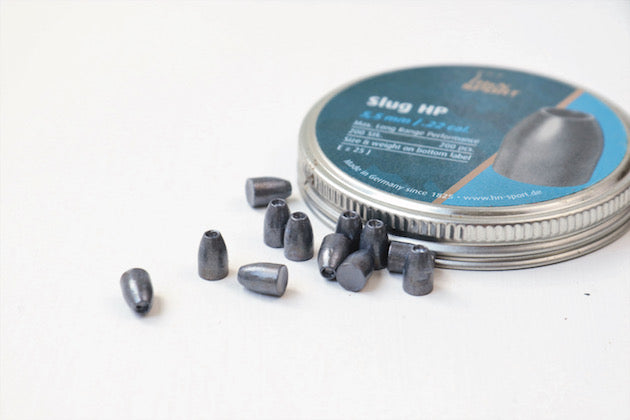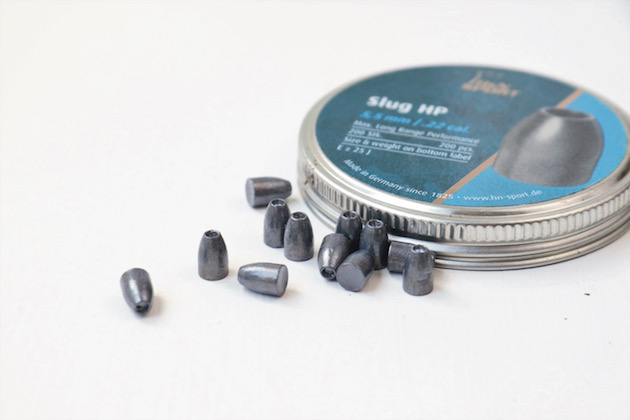
How to choose the best air rifle pellets
Share
Airguns are picky about pellets. Matt Clarke offers some tips on finding the right ammo for your airgun.

TAGS:Best listsSporting Gun
Having the best air rifle pellets for your particular gun can make the difference between hit and miss. So how can you decide? Read through the following and you’ll be in a good position to make the right purchase – and make that all-important difference to your shooting.

Pellets come in all shapes and sizes, but not all of them will be right for your airgun
Best air rifle pellets for different purposes
There is a dazzling array of pellets on the market, all for different disciplines. They range from pointed ones, hollow points, roundheads and ones with a ball bearing in the nose. But the one you’re most likely to see is the pellet designed for general use, which has a round head.

A magazine of air rifle pellets
The general use round head pellet cuts through the air more efficiently than the other shapes of pellets. This means it loses less energy, is less likely to be blown off course by side winds and flies to the target quicker than any other type of pellet. If you want the technical term, it’s said to have a greater ballistic coefficient (BC).

Wadcutters pellets have flat heads and so a poor ballistic co-efficient (BC). This means they are only good at close ranges.
Pointed pellets are designed for hunting but need to be handled gently as they can often have their points damaged in transit which causes them to be inaccurate.
Hollow point pellets are designed to work like dum-dum bullets and spread on impact to impart more damage to the quarry. Like flathead pellets these are best used at close-quarters, such as rat shooting because of their poor BC.
What are the calibres of air rifle pellets?
Air rifle pellets come in four main calibres (sizes): .177; .20; .22 and .25, with .177 being the smallest and .25 being the largest. There is also a .303 calibre pellet, but that is rather specialist and was designed for the awesomely powerful FAC-rated Daystate Wolverine.

Getting the right pellet for your air rifle could make you a better hunter
.22 or .177 calibre?
The .22 used to be considered the best option for hunting because it ensured a clean kill due to its energy. However nowadays the smaller .177 calibre is more popular in sub-12ft/lbs air rifles. It doesn’t impart as much energy to the quarry as it is smaller and lighter but, if hit in the right place such as the head, the animal will be killed cleanly.
It is easier to hit the target with a .177 because it has a flatter trajectory (as it is lighter) and so you don’t have to allow as much hold over as you do with a heavier .22.
You should know that pellets in the same calibre can be a slightly different size. For example .22 pellets can be found in 5.50mm or 5.52mm. A larger size won’t damage your barrel, it’s just that some are a slightly tighter fit than others.

With larger pellets such as the .25 the trajectory in a sub 12ft/lbs airgun is rather “loopy” and so it is best to use this calibre for FAC-rated airguns, or for rat shooting where you shoot at relatively close ranges.
Best air gun pellets for target shooting?
If you’re in a match, the .177 is the pellet to use. Target pellets often have flat heads and are called wad-cutters because they punch a neat hole in the paper target, which makes scoring easier.
What about pellet weight?
Airgun pellets come in a variety of weights.
A general rule is that low-powered airguns should use lighter pellets and high-powered ones should use heavier pellets. Put a heavy pellet in a low-powered airgun and you will get a trajectory that arcs like a rainbow.

A nice tight grouping is what you strive for
FAC-rated airguns should use heavy pellets to absorb the extra energy that comes from the greater power. For legal limit airguns (those under 12ft/lbs.) pellets of seven to eight grains are good for .177 and 14 to 16 grains in .22.
“You will often find that airguns from the same manufacturer prefer different brands of pellet”
Airguns are known for being fussy about the pellets used. Often an airgun from a certain manufacturer prefers a certain brand of pellet.
So which should you go for? The only way to find out is by trial and error. Don’t skimp on your research – airgun pellets are pretty cheap and using the right one will make a big difference to your hit rate.
On the other hand if you haven’t got the time or inclination to test out pellets, just buy the the same brand of pellet as your airgun. I have found that my Air Arms S-410 air rifle works well with Air Arms pellets. If the airgun manufacturer doesn’t have its own brand of pellets, it will tell you which pellet its rifles generally prefer.
What about prices of pellets?
More expensive pellets can be better made than cheaper ones but it doesn’t mean they will perform better in your rifle.
PCP Air Rifles are more efficient with a heavy pellet.

.22 non lead air rifle pellets
Lead-free air rifle pellets
Are these pellets as accurate as traditional airgun ammunition and could they harm gun barrels? Go for a quality brand and the finish and consistency should certainly be on a par with lead ammunition. But lead-free pellets are usually lighter than their lead counterparts so wind can have a serious impact on accuracy. This can make shot placement unpredictable at longer ranges.
air rifles and pistols, mostly of British manufacture. I want to ensure that all of them are legal and do not exceed the legal limit. As the maximum energy law has been in force for around 50 years, there must surely be some standard tests and appropriate pellets.
A: The current law states that if an air rifle is capable of producing a muzzle energy in excess of 12ft/lb, or 6ft/lb in the case of an air pistol, then it would be classified as a firearm and would be subject to a firearms certificate
It does not specify how the energy test should be conducted, nor does it stipulate what type, size and weight of pellet or missile should be used in the test.
The material from which it should be produced, or any other specification of the equipment used in the test, is not specified either.
This is then further complicated by the fact that there are no established bore sizes for airgun barrels as there are for rifle and shotgun barrels
My advice would be to use a waisted Diablo-shaped lead pellet of average weight, 7-gr to 8-gr for .177 or 4.5mm barrels, and a 14-gr to 15-gr pellet for .22 or 5.5mm barrels, with a 16-gr to 18-gr pellet for pre-1968 .22 with 5.6mm barrels.

Slug style pellets can have their place in an FAC rifle but they’re to be avoided in a sub 12 ftlb
Q: I’ve heard that loading airgun pellets backwards is a great way to achieve a dum-dum effect when controlling pests such as rats. Does it work and could it damage the barrel of my airgun?
A: Loading airgun pellets backwards is unlikely to harm your barrel but it is not conducive to accurate airgun shooting either. Airgun ammunition is designed to be propelled by a blast of air that is captured by the skirt at the rear of the pellet, and to rotate around the pellet’s waist as it travels through the air, nose forward. Pellets that are loaded backwards tend to perform very poorly downrange, and group extremely inconsistently at anything much more than 10m.
high powered airguns My advice would be to give it a try but don’t be surprised if normal pellets still give the best results with your sub-12ft/lb airgun. Slugs are also prone to ricochet, so make sure you do your testing in a safe place with a good backstop behind your target.
How to match the pellet to your air rifle barrel




